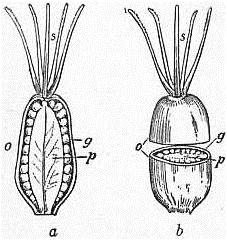CARYOPHYLLACEAE, a botanical order of dicotyledonous plants, containing about 60 genera with 1300 species, and widely distributed, especially in temperate, alpine and arctic regions. The plants are herbs, sometimes becoming shrubby at the base, with opposite, simple, generally uncut leaves and swollen nodes. The main axis ends in a flower (definite inflorescence), and flower-bearing branches are borne one on each side by which the branching is often continued (known technically as a dichasial cyme). The flowers are regular, with four or five sepals which are free or joined to form a tube in their lower portion, the same number of petals, free and springing from below the ovary, twice as many stamens, inserted with the petals, and a pistil of two to five carpels joined to form an ovary containing a large number of ovules on a central placenta and bearing two to five styles; the ovary is one-celled or incompletely partitioned at the base into three to five cells; honey is secreted at the base of the stamens. The fruit is a capsule containing a large number of small seeds and opening by apical teeth; the seed contains a floury endosperm and a curved embryo.
Fig. 1.—Stitchwort (Stellaria Holostea). 1, Flower cut vertically;
2, seed; 3, same cut vertically; 4, same cut horizontally.
Fig. 2.—1, Flowering shoot of Pink (Dianthus); 2, horizontal plan of flower; 3, flower in vertical section.
The order is divided into two well-defined tribes which are distinguished by the character of the flower and the arrangements for ensuring pollination.
Tribe I. Alsineae: the sepals are free and the flowers are open, with spreading petals, and the honey which is secreted at the base of the stamens is exposed to the visits of short-tongued insects, such as flies and small bees; the petals are white in colour. It includes several British genera, Cerastium (mouse-ear chickweed), Stellaria (fig. 1) (stitchwort and chickweed), Arenaria (sandwort), Sagina (pearlwort), Spergula (spurrey) and Spergularia (sandwort spurrey).
Fig. 3.
b, The same cut horizontally, and the halves separated so as to show the interior of the cavity of the ovary o, with the free central placenta p, covered with ovules g.
Tribe II. Sileneae: the sepals are joined below to form a narrow tube, in which stand the long claws of the petals and the stamens, partly closing the tube and rendering the honey inaccessible to all but long-tongued insects such as the larger bees and Lepidoptera. The flowers are often red. It includes several British genera:—Dianthus (pink) fig. 2, Silene (catchfly, bladder campion), Lychnis (campion, L. Flos-Cuculi is ragged robin), and Githago or Agrostemma (corn cockle). Several, such as Lychnis vespertina, Silene nutans and others, are night-flowering, opening their flowers and becoming scented in the evening or at night, when they are visited by night-flying moths.
The plants of this order are of little or no economic value, soap-wort, Saponaria officinalis, forming a lather in water was formerly officinal. Dianthus (carnation and pink) Gypsophila, Lychnis and others, are garden plants.


